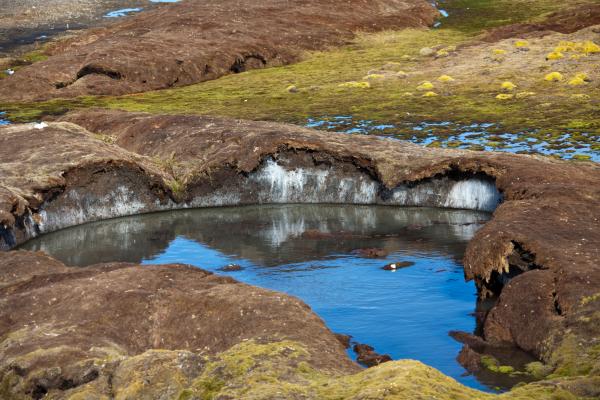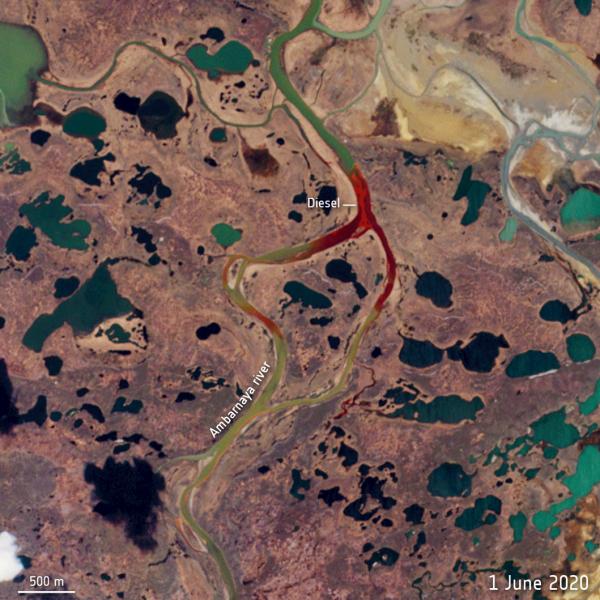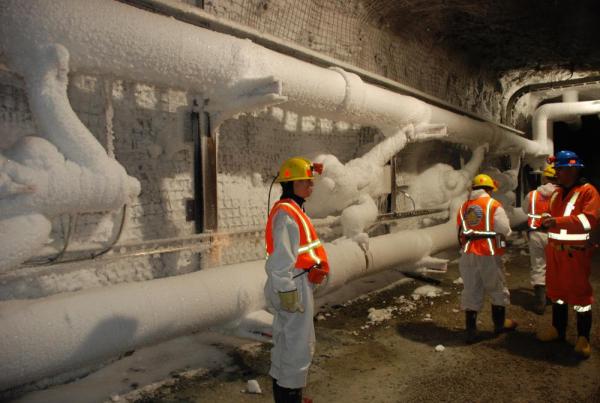By Daria Shapovalova

Co-director, Aberdeen University Centre for Energy Law
dshapovalova@abdn.ac.uk
Posted April 23, 2021
Permafrost, or continuously frozen ground, covers about 24 percent of the Northern Hemisphere, including 50 percent of Canada, more than 60 percent of Russia, and almost 85 percent of Alaska. Scientific understanding and modelling of long-term permafrost dynamics are still at the development stage [1, 2] but the effects of thawing permafrost on Arctic coastline erosion and infrastructure collapse are already causing concerns.

Global warming and Arctic permafrost thaw
Permafrost is a substantial sink of CO2 and methane, making it significant to the global climate, and release of these greenhouse gases from thawing permafrost is predicted to be similar in magnitude to that caused by land-use change [3]. Further effects of permafrost warming in the Arctic include increased flooding, precipitation, and coastline erosion, already occurring in some regions [2, 4].
Aside from the critical changes that warming permafrost inflicts on the Arctic ecosystems, the implications for man-made infrastructure are also substantial, raising questions about adaptation measures and liability for potential damage to structures and the environment. The recent IPCC report on the Ocean and Cryosphere estimates that by 2050, 70 percent of Arctic infrastructure will be located “in regions at risk from permafrost thaw and subsidence” [2].

Why is this a concern today?
The disintegration of buildings and infrastructure is not only a safety and financial risk but an environmental one too. In May 2020, permafrost thaw caused an oil tank to collapse near the city of Norilsk in the Russian Arctic. The accident led to more than 21,000 metric tonnes of oil leaking into the nearby Ambarnaya River, polluting an area of about 180,000 m2 [5].
Permafrost disintegration can further release toxic waste from past extractive operations, as seen in an unfortunate example from Canada. After the Giant Mine operations were concluded near Yellowknife in 2004, attention was turned to the 237,000 tonnes of arsenic trioxide left behind in underground storage, enough to kill every human on the planet. To keep the poisonous waste contained, the government commissioned a project to artificially freeze the ground around the arsenic [6]. Aside from the financial implications for the taxpayers in the form of a bill for US$900 million, the remediation to and inclusion of the local Dene communities are reported to be far from satisfactory [7].
It is clear that in the rapidly warming Arctic the thawing permafrost presents challenges that will require large financial commitments and comprehensive, inclusive approaches. Yet responsibilities for adaptation and liability for any potential damage of permafrost thaw are not well-defined, either in international or in the Arctic States’ law.
Policy implications of permafrost degradation
While the Arctic Council is an appropriate venue for high-level discussions and vital scientific assessments [1], the relevant policies will need to be adopted at the national level. In particular, there is a need to ensure that any new projects consider longer-term warming effects and potential permafrost disintegration. For example, the Yamal liquefied natural gas plant in Russia was built using specially engineered solutions, including pile foundations and thermosyphoning for soil refrigeration [8]. Existing buildings and infrastructure projects need to be thoroughly inspected and reinforced where required, starting with those most at risk.
There is a need for clarification of obligations and liabilities between different levels and sectors of governance in the Arctic States. An example of permafrost thaw as an emerging legal and policy issue is the recently unveiled Russian climate adaptation and Arctic policies.

Permafrost in Russian law and policy
Russia’s 2020 climate adaptation plan acknowledges the negative effects that permafrost degradation will have on buildings and communications. While no concrete measures for permafrost have been outlined yet, more elaborate sectoral and regional adaptation plans are expected to be drawn up in the next two years [9].
In its recently adopted Arctic 2035 Strategy, Russia further stresses the impacts of warming on the Arctic zone and calls for more rigorous monitoring and implementation of engineering solutions to stabilize infrastructure, with particular attention to critical and potentially risky objects [10]. Given the quantity of oil and gas infrastructure it has located in the Arctic, Russia could face billions of dollars in damages from permafrost degradation [11].
In 2018, Yakutiya (Sakha Republic) became the first region in Russia to adopt a law specifically on permafrost protection, establishing a legal framework for monitoring and preservation, as well as a general obligation to compensate for damage to health, property, and the environment caused by permafrost degradation [12]. While the Yakutiya region is especially affected by permafrost degradation, there are also calls for the development of a permafrost protection framework at the federal level [13].
Momentum for action
With Russia’s long-awaited ratification of the Paris Agreement and the inauguration of the Biden administration in the United States, there is finally momentum to adopt more ambitious climate policies and facilitate meaningful scientific and policy-making cooperation in the Arctic Council. While developing more ambitious policies and measures in the next decade will be crucial for long-term climate action, the attention should not only be on mitigation but adaptation as well. More importantly, Arctic communities already affected by thawing grounds and coasts need government to take urgent action to prevent damage to health and the environment through inclusive decision-making.
The views expressed are those of the author and do not necessarily reflect the policies or positions of the East-West Center or of any other organization.
References
[1] Arctic Monitoring & Assessment Programme (AMAP; 2017), Snow, Water, Ice and Permafrost in the Arctic (SWIPA)
[2] Intergovernmental Panel on Climate Change (IPCC; 2019), Special Report on the Ocean and Cryosphere in the Changing Climate
[3] E.A.G. Schuur et al. (2015), “Climate Change and the Permafrost Carbon Feedback,” Nature 520: 171.
[4] B.M. Jones et al. (2020), Coastal Permafrost Erosion, NOAA Arctic Report Card 2020, https://www.arctic.noaa.gov/Portals/7/ArcticReportCard/Documents/ArcticReportCard_full_report2020.pdf?ver=2020-12-08-151255-807
[5] D. Shapovalova (2020) Oil Spill in Siberia: Are We Prepared for Permafrost Thaw?, The Arctic Institute, https://www.thearcticinstitute.org/oil-spill-siberia-prepared-permafrost-thaw/
[6] Indigenous and Northern Affairs Canada, Giant Mine Remediation Project, https://www.aadnc-aandc.gc.ca/eng/1100100027364/1100100027365
[7] J. Sandlos and A. Keeling (2016) “Aboriginal Communities, Traditional Knowledge, and the Environmental Legacies of Extractive Development in Canada,” The Extractive Industries and Society 3(2): 278.
[8] Total, Yamal LNG project, https://www.ep.total.com/en/areas/liquefied-natural-gas/our-yamal-lng-project-russia/foundations-permafrost-engineering
[9] Government of the Russian Federation (25 December 2019), National Plan on Measures for the First Stage of Climate Adaptation to 2022 (no 3183-r), [in Russian], http://static.government.ru/media/files/OTrFMr1Z1sORh5NIx4gLUsdgGHyWIAqy.pdf
[10] President of the Russian Federation (26 October 2020), Strategy for the Development of the Arctic Zone of the Russian Federation and Ensuring National Security to 2035 (Russia Arctic Strategy; order no. 645) [in Russian], http://kremlin.ru/acts/news/64274
[11] M. Polovtseva (2020), A Blessing and a Curse: Melting Permafrost in the Russian Arctic The Arctic Institute, https://www.thearcticinstitute.org/blessing-curse-melting-permafrost-russian-arctic/
[12] Sakha Republic Law (22 May 2018) On Permafrost Protection in Sakha Republic (No. 1571-V) [in Russian], https://iltumen.ru/documents/12669
[13] Ria Novosti (2018), Il Tumen Calls for the Development of a Federal Law on Permafrost Protection [in Russian], https://ria.ru/20181212/1547852429.html
By Daria Shapovalova

Co-director, Aberdeen University Centre for Energy Law
dshapovalova@abdn.ac.uk
Posted April 23, 2021
Permafrost, or continuously frozen ground, covers about 24 percent of the Northern Hemisphere, including 50 percent of Canada, more than 60 percent of Russia, and almost 85 percent of Alaska. Scientific understanding and modelling of long-term permafrost dynamics are still at the development stage [1, 2] but the effects of thawing permafrost on Arctic coastline erosion and infrastructure collapse are already causing concerns.

Global warming and Arctic permafrost thaw
Permafrost is a substantial sink of CO2 and methane, making it significant to the global climate, and release of these greenhouse gases from thawing permafrost is predicted to be similar in magnitude to that caused by land-use change [3]. Further effects of permafrost warming in the Arctic include increased flooding, precipitation, and coastline erosion, already occurring in some regions [2, 4].
Aside from the critical changes that warming permafrost inflicts on the Arctic ecosystems, the implications for man-made infrastructure are also substantial, raising questions about adaptation measures and liability for potential damage to structures and the environment. The recent IPCC report on the Ocean and Cryosphere estimates that by 2050, 70 percent of Arctic infrastructure will be located “in regions at risk from permafrost thaw and subsidence” [2].

Why is this a concern today?
The disintegration of buildings and infrastructure is not only a safety and financial risk but an environmental one too. In May 2020, permafrost thaw caused an oil tank to collapse near the city of Norilsk in the Russian Arctic. The accident led to more than 21,000 metric tonnes of oil leaking into the nearby Ambarnaya River, polluting an area of about 180,000 m2 [5].
Permafrost disintegration can further release toxic waste from past extractive operations, as seen in an unfortunate example from Canada. After the Giant Mine operations were concluded near Yellowknife in 2004, attention was turned to the 237,000 tonnes of arsenic trioxide left behind in underground storage, enough to kill every human on the planet. To keep the poisonous waste contained, the government commissioned a project to artificially freeze the ground around the arsenic [6]. Aside from the financial implications for the taxpayers in the form of a bill for US$900 million, the remediation to and inclusion of the local Dene communities are reported to be far from satisfactory [7].
It is clear that in the rapidly warming Arctic the thawing permafrost presents challenges that will require large financial commitments and comprehensive, inclusive approaches. Yet responsibilities for adaptation and liability for any potential damage of permafrost thaw are not well-defined, either in international or in the Arctic States’ law.
Policy implications of permafrost degradation
While the Arctic Council is an appropriate venue for high-level discussions and vital scientific assessments [1], the relevant policies will need to be adopted at the national level. In particular, there is a need to ensure that any new projects consider longer-term warming effects and potential permafrost disintegration. For example, the Yamal liquefied natural gas plant in Russia was built using specially engineered solutions, including pile foundations and thermosyphoning for soil refrigeration [8]. Existing buildings and infrastructure projects need to be thoroughly inspected and reinforced where required, starting with those most at risk.
There is a need for clarification of obligations and liabilities between different levels and sectors of governance in the Arctic States. An example of permafrost thaw as an emerging legal and policy issue is the recently unveiled Russian climate adaptation and Arctic policies.

Permafrost in Russian law and policy
Russia’s 2020 climate adaptation plan acknowledges the negative effects that permafrost degradation will have on buildings and communications. While no concrete measures for permafrost have been outlined yet, more elaborate sectoral and regional adaptation plans are expected to be drawn up in the next two years [9].
In its recently adopted Arctic 2035 Strategy, Russia further stresses the impacts of warming on the Arctic zone and calls for more rigorous monitoring and implementation of engineering solutions to stabilize infrastructure, with particular attention to critical and potentially risky objects [10]. Given the quantity of oil and gas infrastructure it has located in the Arctic, Russia could face billions of dollars in damages from permafrost degradation [11].
In 2018, Yakutiya (Sakha Republic) became the first region in Russia to adopt a law specifically on permafrost protection, establishing a legal framework for monitoring and preservation, as well as a general obligation to compensate for damage to health, property, and the environment caused by permafrost degradation [12]. While the Yakutiya region is especially affected by permafrost degradation, there are also calls for the development of a permafrost protection framework at the federal level [13].
Momentum for action
With Russia’s long-awaited ratification of the Paris Agreement and the inauguration of the Biden administration in the United States, there is finally momentum to adopt more ambitious climate policies and facilitate meaningful scientific and policy-making cooperation in the Arctic Council. While developing more ambitious policies and measures in the next decade will be crucial for long-term climate action, the attention should not only be on mitigation but adaptation as well. More importantly, Arctic communities already affected by thawing grounds and coasts need government to take urgent action to prevent damage to health and the environment through inclusive decision-making.
The views expressed are those of the author and do not necessarily reflect the policies or positions of the East-West Center or of any other organization.
References
[1] Arctic Monitoring & Assessment Programme (AMAP; 2017), Snow, Water, Ice and Permafrost in the Arctic (SWIPA)
[2] Intergovernmental Panel on Climate Change (IPCC; 2019), Special Report on the Ocean and Cryosphere in the Changing Climate
[3] E.A.G. Schuur et al. (2015), “Climate Change and the Permafrost Carbon Feedback,” Nature 520: 171.
[4] B.M. Jones et al. (2020), Coastal Permafrost Erosion, NOAA Arctic Report Card 2020, https://www.arctic.noaa.gov/Portals/7/ArcticReportCard/Documents/ArcticReportCard_full_report2020.pdf?ver=2020-12-08-151255-807
[5] D. Shapovalova (2020) Oil Spill in Siberia: Are We Prepared for Permafrost Thaw?, The Arctic Institute, https://www.thearcticinstitute.org/oil-spill-siberia-prepared-permafrost-thaw/
[6] Indigenous and Northern Affairs Canada, Giant Mine Remediation Project, https://www.aadnc-aandc.gc.ca/eng/1100100027364/1100100027365
[7] J. Sandlos and A. Keeling (2016) “Aboriginal Communities, Traditional Knowledge, and the Environmental Legacies of Extractive Development in Canada,” The Extractive Industries and Society 3(2): 278.
[8] Total, Yamal LNG project, https://www.ep.total.com/en/areas/liquefied-natural-gas/our-yamal-lng-project-russia/foundations-permafrost-engineering
[9] Government of the Russian Federation (25 December 2019), National Plan on Measures for the First Stage of Climate Adaptation to 2022 (no 3183-r), [in Russian], http://static.government.ru/media/files/OTrFMr1Z1sORh5NIx4gLUsdgGHyWIAqy.pdf
[10] President of the Russian Federation (26 October 2020), Strategy for the Development of the Arctic Zone of the Russian Federation and Ensuring National Security to 2035 (Russia Arctic Strategy; order no. 645) [in Russian], http://kremlin.ru/acts/news/64274
[11] M. Polovtseva (2020), A Blessing and a Curse: Melting Permafrost in the Russian Arctic The Arctic Institute, https://www.thearcticinstitute.org/blessing-curse-melting-permafrost-russian-arctic/
[12] Sakha Republic Law (22 May 2018) On Permafrost Protection in Sakha Republic (No. 1571-V) [in Russian], https://iltumen.ru/documents/12669
[13] Ria Novosti (2018), Il Tumen Calls for the Development of a Federal Law on Permafrost Protection [in Russian], https://ria.ru/20181212/1547852429.html

